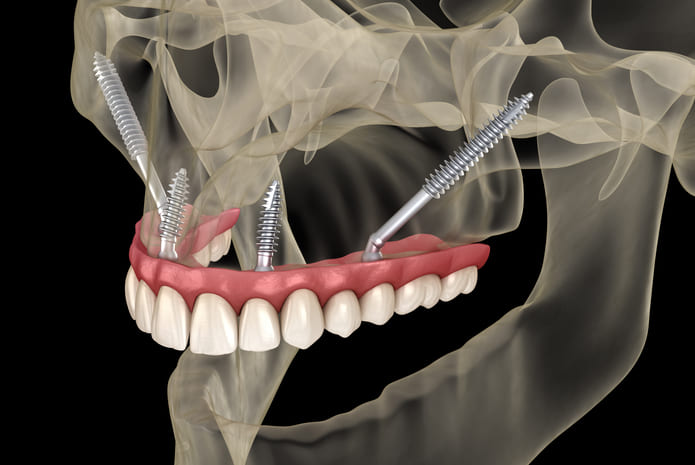La atrofia severa del maxilar superior exige la realización de técnicas quirúrgicas complejas para la colocación de los implantes como son los injertos óseos, la elevación de seno maxilar, la colocación de implantes con fijación en la apófisis pterigoides y en el cuerpo del hueso cigomático, entre otros (1-4).
Los implantes cigomáticos se han convertido en una opción eficaz de los pacientes con atrofia severa del maxilar superior y representan una buena solución para conseguir una fijación maxilar posterior y poder rehabilitar exitosamente de forma
inmediata casi siempre (5-7). Dicho tratamiento requiere de un plan complejo que incluye un diagnóstico radiológico tomográfico computarizado, estricto protocolo quirúrgico, una adecuada rehabilitación prostodóntica y revisiones periódicas para conseguir un éxito a largo plazo.
La trayectoria del implante cigomático puede ser yuxta oextrasinusal con respecto al seno maxilar para lograr que la cabeza del implante tenga su punto de emergencia en la cresta alveolar y permita una restauración protésica más favorable para el paciente (8-11).
Palabras clave: cigomático, pterigoideos, injerto óseo, intrasinusal, extrasinusal, impresión 3D.
Abstract
Severe atrophy of the upper jaw requires complex surgical techniques for implant placement, such as bone grafts, maxillary sinus lift, placement of implants with fixation in the pterygoid process and in the body of the zygomatic bone among others.
Zygomatic implants have become an effective option for patients with severe maxillary atrophy and represent a good solution to achieve posterior maxillary fixation and to be able succesfully rehabilitate immediately almost always. This treatment requires a complex plan that includes a computed tomographic radiological diagnosis, strict surgical protocol, adequate prosthodontic rehabilitation and periodic check-ups to achieve longterm succes.
The trajectory of the zygomatic implants can be juxta or extrasinusal with respect to the maxillary sinus to ensure that the implant head has its emergence point in the alveolar crest and allows a more favorable prosthetic restoration for the patient.
Keywords: zygomatic, pterygoid, bone graft, juxta , extrasinusal, 3D printing.





